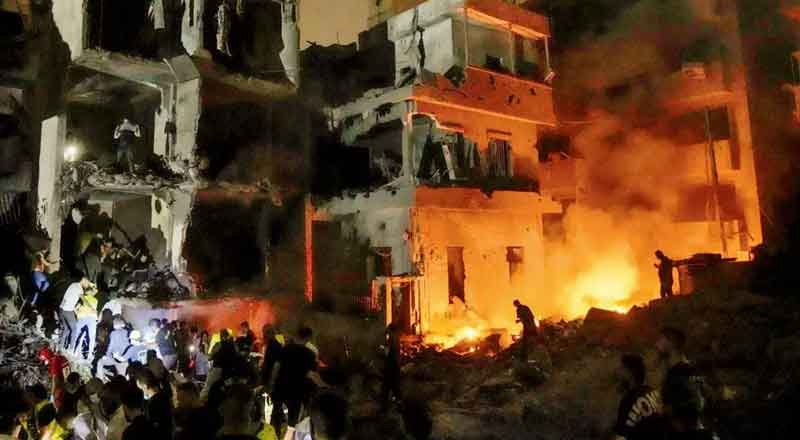Escalating Tensions: Hezbollah and Israel Exchange Deadly Strikes Amid Intensified Conflict
In the ongoing conflict between Israel and Hezbollah, the latest wave of attacks has resulted in significant casualties on both sides. On Sunday, a Hezbollah drone strike on an Israeli army base in central Israel claimed the lives of four Israeli Defense Forces (IDF) soldiers and severely injured seven others. Meanwhile, in Gaza, an Israeli airstrike on a school-turned-shelter killed at least 20 people, including children. As violence escalates on multiple fronts, civilians in the region continue to face devastating losses.
Hezbollah’s Retaliation: A Drone Strike on Israeli Forces
Hezbollah, the Lebanon-based militant group, launched a drone strike near Binyamina city, targeting Israel’s elite Golani brigade. The attack, which Hezbollah claimed was in retaliation for Israeli airstrikes on Beirut that had killed 22 people earlier in the week, was part of a broader assault designed to overwhelm Israeli air-defense systems. Dozens of missiles were launched alongside the drones, which managed to evade detection by Israeli radars.
The strike resulted in 61 casualties, including the deaths of four IDF soldiers and serious injuries to seven others. This attack is one of the deadliest Hezbollah operations against Israel since the current conflict intensified. The use of Iranian-made drones, which are small and difficult to detect, has posed a significant challenge for Israel’s advanced air-defense systems.
Israeli Airstrike on Gaza School
On the same day, Gaza witnessed another tragic incident when an Israeli airstrike hit a school in Nuseirat, which had been converted into a shelter for displaced Palestinians. At least 20 people, including several children, lost their lives in the attack. The victims were taken to Al-Awda Hospital in Nuseirat and Al-Aqsa Martyrs Hospital in Deir al-Balah.
Gaza’s Health Ministry reports that the ongoing Israeli bombardment and ground invasion have claimed the lives of over 42,000 Palestinians, with many more injured. The school was one of the numerous civilian sites targeted in the conflict, which has caused widespread displacement and destruction throughout the region.
Hezbollah’s Strategy: Drones and Missiles
The Hezbollah drone strike marked a significant escalation in the ongoing hostilities between Israel and the group. Hezbollah’s use of drones has been a growing concern for Israeli forces, particularly as these unmanned aerial vehicles are becoming increasingly sophisticated and harder to detect. The attack on Binyamina was described by Hezbollah as a “complex” operation involving squadrons of drones and a barrage of missiles aimed at neutralizing Israeli defense systems.
The drones managed to strike a dining hall at the military base during the evening meal, causing significant casualties. The group claimed that the drones exploded in rooms where dozens of Israeli officers and soldiers were present.
U.S. Sends Missile Defense System to Israel
In response to the growing threat posed by Hezbollah and other militant groups, the United States announced on Sunday that it would send a Terminal High Altitude Area Defense (THAAD) missile defense system to Israel. This advanced system, along with approximately 100 U.S. troops, is intended to bolster Israel’s defense against missile and drone attacks. The THAAD system is designed to intercept and destroy short, medium, and intermediate-range ballistic missiles during their final phase of flight.
U.S. President Joe Biden stated that the deployment was necessary “to defend Israel” as the country faces escalating threats from Iran and its proxies. Iran had fired over 180 missiles at Israel earlier in October, raising concerns about a broader regional conflict.
Hezbollah’s Threat of More Attacks
Hezbollah has vowed to continue its attacks on Israel if the country does not cease its operations in Lebanon. The group warned that more drone and missile strikes could follow if Israel’s offensive continues, further intensifying the already volatile situation in the region.
The United Nations has also raised concerns about the escalating violence. UN Secretary-General António Guterres condemned attacks on peacekeepers in Lebanon, after two Israeli tanks destroyed a gate and forcibly entered a UN peacekeeping base. Guterres emphasized that targeting peacekeepers is a violation of international law and could constitute a war crime.
Civilians Caught in the Crossfire
As the conflict rages on, civilians remain the most vulnerable, bearing the brunt of the violence on both sides. In Gaza, hospitals are overwhelmed with casualties from airstrikes, and the number of displaced individuals continues to rise. Israeli strikes on civilian infrastructure, including schools and hospitals, have drawn international condemnation, while Hezbollah’s missile and drone attacks are creating fear and chaos within Israel.
The humanitarian crisis in Gaza is worsening by the day, with thousands of families displaced and vital infrastructure destroyed. The Israeli military insists that its operations target militants, but the high number of civilian casualties has raised concerns about the proportionality of the response.
Outlook: Continued Escalation
With Hezbollah threatening more attacks and Israel continuing its operations in Lebanon and Gaza, the conflict shows no signs of abating. Both sides are entrenched in a cycle of retaliation, with civilians paying the highest price. The involvement of the United States, through the deployment of missile defense systems, underscores the growing international dimensions of the conflict.
As diplomatic efforts to resolve the crisis stall, the region remains on edge, bracing for further violence in the days to come.
(With inputs from agencies)





